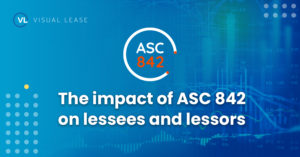
The new lease accounting standards have radically changed the way private and public companies record leases on the balance sheet. Naturally, this had a direct impact on lessees, lessors and how they classify lease agreements.
Under ASC 842, lease agreements are defined as “a contract, or part of a contract, between a lessor and a lessee that conveys the right to control the use of identified property, plant, or equipment (an identified asset) to the lessee for a period of time in exchange for consideration.“
Both the lessee and lessor are signatories to the agreement and must abide by its rules. Additionally, both parties will need to classify what kind of lease the agreement is, either finance or operating as defined under ASC 842.
What’s the difference between a lessor and a lessee?
Before we review how both parties classify a lease under ASC 842, let’s take a look at the definitions of a lessor and lessee.
The lessor is the party that either owns or leases and subleases the asset – which can range from property, vehicles or equipment.
The lessee is the party receiving the right to use the asset for a specified period of time, per the lease agreement.
Under ASC 842, the definitions of a lessor and lessee haven’t necessarily changed, however, both parties must change how they present leases in their financial statements.
For the first time, lessees must show all leasing obligations, including operating leases, on the balance sheet – and classify them either as operating or finance leases.
Before ASC 842, operating leases were not included in the balance sheet. This is one of the larger changes lessees must address under ASC 842. Luckily for lessors, this change isn’t as significant because they already had to make these classifications prior to the new lease accounting standard.
What’s the difference between an operating lease and a finance lease?
ASC 842 requires the classification of a lease at the commencement of the lease agreement, based on specified economic criteria. It’s important for both parties to understand these criteria as they determine differences between and classification of an operating lease and a finance lease.
Operating leases are contracts that permit the use of a certain asset without transferring the ownership of that asset for any less than a major part of the asset’s life. For example, the lessee uses the asset, while the lessor provides the maintenance or upkeep of the asset. Expenses related to operating leases were not previously recorded on a company’s balance sheet until ASC 842. The leased asset, along with the corresponding liabilities, are now presented on the balance sheet.
A finance lease is a contract that does not qualify as an operating lease; the risks and rewards associated with the leased asset get transferred to the lessee. In other words, they have full control of the asset. Under ASC 842, finance leases continue to be recorded on the lessee’s balance sheet as an asset with a corresponding liability.
The impact of ASC 842 and the importance of lease accounting software
Although lessees and lessors have not fundamentally changed under ASC 842, the impact of the new lease accounting standard has required both parties (especially lessees) to classify their leases with a higher degree of scrutiny.
Given the transparent nature of ASC 842, whether it’s a finance or operating lease, both parties need to ensure they are properly accounting for them on the balance sheet.
Lease classification is just one of the many complexities of ASC 842. To ensure your lease data and financial reports remain accurate, you’ll want to make sure your lease data is always up-to-date and organized in one centralized location. By utilizing lease management and lease accounting software such as Visual Lease, you’ll be able to leverage the platform as your single source of truth to manage and track your lease data.
Visit our blog to stay up to date on the latest news, trends and tips in lease accounting.
Looking for more information or have a lease accounting question? Get in touch with one of our lease accounting experts. Click here to schedule time with one now.























